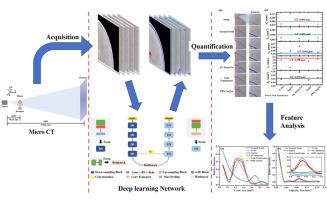基于深度学习和微CT图像处理的PBX微缺陷表征
IF 3.9
Q2 CHEMISTRY, MULTIDISCIPLINARY
引用次数: 0
摘要
聚合物粘结炸药(PBX)是一种主要由炸药晶体和粘结剂组成的复合炸药。PBX内部存在裂纹和杂质,影响其力学性能和爆轰性能。PBX内部结构的高填充颗粒性和异质性特点,加上PBX内部缺陷对比度低、比例小,给PBX内部缺陷的精确分割和量化带来了很大的挑战。本文提出了基于卷积神经网络的PBX_SegNet用于PBX缺陷分割。PBX_SegNet是建立在U-Net的编码器-解码器架构之上的。我们优化了PBX_SegNet中的跳跳连接结构,并在编码器网络和解码器网络的每一级引入了并发的空间和信道挤压和激励(SCSE)模块。我们在PBX缺陷数据集上训练和评估PBX_SegNet,该数据集由微计算机断层扫描(μCT)获得的图像组成。使用相同的测试数据集,将该方法与基于深度学习的四种主流分割方法进行比较和评估。结果表明,PBX_SegNet实现了PBX裂缝与杂质的同时分割,并利用图像处理方法对分割结果进行处理,进一步完成了PBX裂缝与杂质的定量表征。PBX_SegNet在3个PBX缺陷数据集上的平均Dice得分(Dice)为0.9965,裂纹相对面积(RAC)为0.9033,杂质相对面积(RAI)为0.9511,优于目前4种最先进的方法,提高了低对比度、小比例的缺陷分割和量化表征能力。所提出的方法有望分割来自各种领域或成像技术的图像中的细微,低对比度缺陷。本文章由计算机程序翻译,如有差异,请以英文原文为准。

PBX micro defect characterization by using deep learning and image processing of micro CT images
Polymer bonded explosive (PBX) is a composite explosive mainly made up of explosive crystals and binders. The presence of cracks and impurities within PBX impacts its mechanical properties and detonation performance. The highly filled granular nature and heterogeneous characteristics of PBX's internal structure, combined with the low contrast and small proportion of defects in PBX, present significant challenges for the precise segmentation and quantification of internal defects in PBX. In this paper, we proposed PBX_SegNet for PBX defect segmentation based on convolutional neural network. The PBX_SegNet is built on the encoder–decoder architecture of U-Net. We optimize the structure of skip connection in PBX_SegNet and introduce a concurrent spatial and channel squeeze and excitation (SCSE) module on each stage in the encoder network and in the decoder network. We train and evaluate PBX_SegNet on PBX defect dataset which consists of images acquired by micro computed tomography (μCT). Using the same test dataset, the proposed method was compared and evaluated against four mainstream segmentation methods based on deep learning. The results demonstrate that PBX_SegNet realizes the simultaneous segmentation of PBX cracks and impurities, and further completes the quantitative characterization of PBX cracks and impurities by processing the segmentation results using image processing methods. PBX_SegNet achieves Dice score (DICE) of 0.9965, crack relative area (RAC) of 0.9033 and impurity relative area (RAI) of 0.9511 on the three PBX defect datasets in average, which outperforms the current four state-of-the-art methods and improves the low contrast and small proportion of defect segmentation and quantification characterization capabilities. The proposed method shows promise for segmenting subtle, low-contrast defects in images from various domains or imaging techniques.
求助全文
通过发布文献求助,成功后即可免费获取论文全文。
去求助
来源期刊

Energetic Materials Frontiers
Materials Science-Materials Science (miscellaneous)
CiteScore
6.90
自引率
0.00%
发文量
42
审稿时长
12 weeks
 求助内容:
求助内容: 应助结果提醒方式:
应助结果提醒方式:


